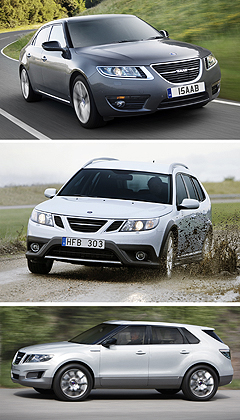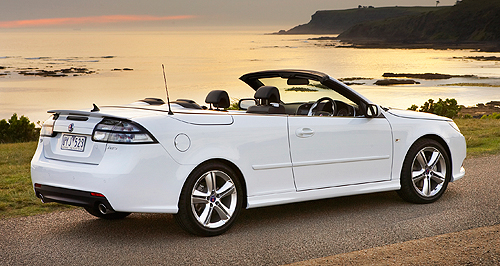Make / Model Search
Future models - Saab - 9-3Spyker commits to new Saab 9-3 by 2012Succession plan: Spyker pledges that the Saab 9-3 will make it into a new generation by 2012. New Saab owner spells out model plans, including a possible baby 9-13 Feb 2010 NEW Saab owner Spyker Cars has confirmed that it will develop a new-generation Saab 9-3 for launch in 2012, as well as investigate the potential for a fourth, small car line, dubbed the 9-1. Spelling out its strategic plan in advance of February 12’s extraordinary general meeting called to secure shareholder approval for its takeover of the troubled Swedish car-maker, Spyker divulged its model aspirations and direction for the next several years under a newly created company, Saab Spyker Automobiles NV. It said the Saab operation would be established as a stand-alone niche manufacturer, with three-to-four model lines: 9-3 (sedan, hatchback, sports estate, X and convertible), the new 9-5 (sedan, sports estate and X) and the new Mexican-made 9-4X crossover. “In addition, Saab will investigate the potential of adding a fourth smaller car line (9-1) in due course, provided that the positive development of the smaller car segment continues,” it said in a statement released in the Netherlands. “However, this model is currently not envisaged in the business plan, so if the outcome of the investigation is positive, additional financing to develop this model could be required. “Saab’s product portfolio will be renewed completely, beginning with the launch of the new 9-5 early this (European) summer, the new 9-4X in early 2011 and the new 'all Saab' 9-3 in 2012.”  From top: Saab 9-5, Saab 9-3X concept, Saab 9-4X. From top: Saab 9-5, Saab 9-3X concept, Saab 9-4X.The current, second-generation Saab 9-3 – launched in 2002 – was based on GM’s Epsilon mid-sized platform that also spawned the Opel/Vauxhall Vectra. The Spyker statement did not indicate if Saab would go it alone with a modification of the current architecture or an all-new platform. Spyker’s statement said that while collaboration on parts and technology with previous owner General Motors would continue to aid economies of scale, Saab would gradually wean itself away from GM, which nevertheless remains a major shareholder in the company. It said it planned to “reduce GM dependency and obtain improved access to other suppliers and the co-development of unique innovations”. Spyker promised to revive the aspirational image of Saab, saying it would target premium competitors such as Audi and BMW – in particular the Audi A4 and A6 and BMW 3 and 5 Series – with its new-generation cars while pitching itself as an “independent, performance-orientated niche car company with an industry-leading environmental strategy”. It indicated that its new models would be developed in-house, saying: “Saab’s technical development centre in Trollhättan has full capability in developing complete vehicles and will continue to do so. “In areas such as safety, environment, driving characteristics, practicality, turbo technologies and several other innovations, the Saab brand is among the best in the industry.” It said it wanted to build its sales back to “pre-crisis levels” of between 100,000 and 125,000 vehicles a year, including the 9-4X built at GM’s plant alongside the similarly-based Cadillac SRX. Spyker also spelled out its $1US billion ($A1.12b) finance arrangements, saying this would be provided through three sources – $US326 million ($A367b) in redeemable preference shares to be issued by Saab to GM a $556 million ($A627m) European Investment Bank (EIB) loan (securing this loan is a condition of the acquisition of Saab) and $200 million ($A225m) in cash held in Saab’s bank account. “With this financing in place, the business plan does not envisage any future funding being required, neither from Spyker or elsewhere, for Saab to return to profitability,” Spyker’s statement said. “The business plan targets car production and sales at or below historical levels of 100,000 to 125,000.” Spyker said the new business plan had been drawn up by Saab management over the past 10 months, and had been scrutinised by its advisers, as well as the Swedish government and the EIB.  Read more28th of January 2010  Saab saviour thanks 'Tassie Devil'How a Hobart website helped to mobilise the ‘Save Saab’ global campaign28th of January 2010  Saab future ‘fantastic’ in AustraliaChange in Saab ownership, distribution to set a course for new growth in Australia27th of January 2010  GM offloads SaabSaab finally sold to Spyker but GM retains part ownershipAll future modelsMotor industry news |
Click to shareSaab modelsResearch Saab All future modelsMotor industry news |


 Alfa Romeo
Alfa Romeo Abarth
Abarth Audi
Audi Aston Martin
Aston Martin BMW
BMW Bentley
Bentley Ferrari
Ferrari Chevrolet
Chevrolet Ford
Ford Fiat
Fiat GWM
GWM Foton
Foton Hyundai
Hyundai Honda
Honda Jaguar
Jaguar Isuzu
Isuzu Kia
Kia Jeep
Jeep Land Rover
Land Rover Lamborghini
Lamborghini Maserati
Maserati Lexus
Lexus McLaren
McLaren Mazda
Mazda Mercedes-Benz
Mercedes-Benz Mitsubishi
Mitsubishi Mini
Mini Peugeot
Peugeot Nissan
Nissan Ram
Ram Porsche
Porsche Rolls-Royce
Rolls-Royce Smart
Smart Skoda
Skoda Suzuki
Suzuki Subaru
Subaru Toyota
Toyota Tesla
Tesla Volvo
Volvo Zeekr
Zeekr







Facebook Twitter Instagram